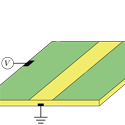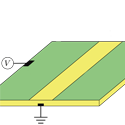Dirac connection
In response to a voltage, the electrical current in a pure sheet of graphene diminishes as , where is the length over which the current is transmitted. This form of scaling, called pseudodiffusive because of its similarity to diffusion in a random potential, occurs when is less than the width of the sheet and the mean free path.
In graphene, pseudodiffusion occurs because the electrons behave like massless Dirac fermions. Now, in a paper appearing in Physical Review B, János Asbóth and collaborators at Leiden University in the Netherlands calculate the transmission of electrons and holes between two normal-metal electrodes, separated over a distance by a clean d-wave superconductor. Asbóth et al. find that the transmitted electrical and thermal currents both have the pseudodiffusive scaling characteristic of massless Dirac fermions—regardless of the presence of tunnel barriers at the metal-superconductor interfaces—as long as is larger than the superconducting coherence length and smaller than the width of the superconductor and the mean free path. This occurs because the d-wave superconductor forms ballistic conduction channels for coupled electron-hole excitations that are described by an anisotropic two-dimensional Dirac equation analogous to that of graphene. This finding is likely to spur experimental efforts to search for pseudodiffusive transmission in clean single crystals of high- cuprates. – Sarma Kancharla





